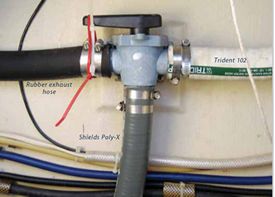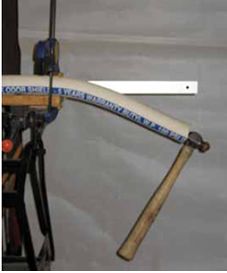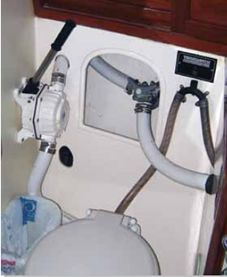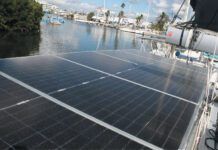There simply is nothing like the smell of the sea. Unfortunately, the smell of a boat with defective sanitation hose is nothing at all like that.
Sanitation hoses are specifically designed to contain odorous gases. They are made of very different materials than the many similar-looking hoses used for fuel, coolant, and tap water—and they are not interchangeable.
In September 2000, Practical Sailor reported on our hose-permeation study, which used carbon disulfide as a surrogate for sewage to test for permeation and other signs of deterioration. SeaLand’s OdorSafe Plus hose was the clear winner in that test, but a few synthetic-rubber hoses known to provide good service failed. One, Trident 102, is known to be dependable, and the maker claims there’s never been a documented failure with it in over 15 years. Hose maker Shields was similarly surprised with its hose’s failure.

Photo by Drew Frye
275
Since carbon disulfide is used as a solvent in the production of rubber, was this test somehow unfair or irrelevant? Much as a pure oxygen atmosphere can cause metals to burst into flame that would never burn in atmospheric oxygen, did the use of a single chemical cause failures that were not real?
Practical Sailor repeated the test using diluted chemical in place of sewage and by using vapor only, but the results were similar. We never were able to establish a correlation between the test bench results using synthetic waste and those using real waste in the field.
One year ago, we launched a new round of long-term waste hose testing. This time, we decided to use actual sewage, the waste of a 20-pound iguana. This article will look at the various hoses and materials we’re testing, and the Value Guide offers our preliminary results after one year. Stay tuned for follow-up reports and for our conclusions after two years of testing.
A Look at Hose Materials
The builder of PS tester Drew Frye’s catamaran, PDQ Yachts, had the good sense to place the holding tank and all of the sanitation hoses in a bulkhead compartment, sealed off from the rest of the boat. Unfortunately, someone also had the poor sense to use clear vinyl hose for the vent lines, which didn’t resist permeation at all, turning yellow and stiff and sticky with a foul surface residue. They also used ordinary reinforced exhaust hose for the sewage and pump-out lines; these didn’t fair much better than the clear vinyl.
Over time, a brown residue of dried permeate formed on the surface, and the whole compartment became foul to the point where retrieving the fishing poles stored there became quite an unpleasant task. It seems a reinforced fuel or coolant hose, no matter how well built, simply can’t contain the stink of stagnant sewage. Given three to five years, the odors simply go right through the wall (permeate), and the boat becomes unlivable.
In a home, sewage is contained by metal and polyvinyl chloride (PVC) pipes—completely impervious to permeation—but these rigid materials usually are not practical on a boat, given the fitting and flexing challenges a marine installation presents. As it turns out, achieving long-term resistance in a flexible product is a real challenge.
Instead of nitrile and neoprene—the material of choice for fuel and exhaust hose—boat owners should look at urethane, butyl, EPDM, and PVC hose for sanitation systems.
Why isn’t PVC pipe, vinyl tubing, or vinyl hose the best choice? Because PVC pipe is rigid, and vinyl hose is softened by adding plasticizers; on a chemical level, these have the effect of leaving the plastic porous. The softer the formulation, the faster acid gases like hydrogen sulfide and carbon disulfide seep through. Soft vinyl tubing fails in months and is included in this test only as a reference point. The vinyl sanitation hose in the test (SeaLand OdorSafe Plus) is very stiff, contains much lower levels of plasticizers, and contains other polymers that help block odors; a hybrid product of sorts. This is a necessary compromise, aimed at delivering the required permeation resistance with adequate flexibility.
Butyl rubber is known for very low gas permeation rates—it’s been used for inner tubes for many years and even today, all tubeless tires use a laminated butyl rubber liner to control air loss—but it doesn’t handle oils well at all. Of course, sanitary waste doesn’t contain oil, and when used properly, head lubricants are too limited in volume to be an issue. However, disposing of any oil or solvent in the head or placing oils in a head plumbing system in a manner where they will be in the hose or head for any period of time is likely to damage any sanitation hose and elastomers in the head itself.
EPDM is a common choice for steam hoses and is used in high-end engine coolant hoses because of its low permeation rates with hot water and glycol (antifreeze). It resists acids and bases well, but has a weakness regarding oil.
Polyurethane has a good combination of chemical resistances and also resists oil. However, air and steam permeation rates are higher than butyl and EPDM, respectively. It is common in hoses used by honey dippers. Whether it resists sewage well, we will see. Waste-hose maker Shields has combined this with other polymers into a composite hose, an approach that is common in chemical hoses.

227
What We Tested
We tested flagship sanitation hoses from four of the market’s leading manufacturers.
The test field included Trident Marine’s 101/102 EPDM hose; SeaLand’s OdorSafe Plus, a PVC and acrylonitrile butadiene rubber hose; Raritan’s butyl rubber Sani/Flex Odor Shield; and Shields Marine’s Poly-X polyurethane sanitation hose.
For comparison, we also tested schedule 40 PVC sanitation pipe and clear vinyl hose made by Trident. PVC pipe was selected as a material known to resist permeation indefinitely, while clear vinyl hose was selected as a material expected to fail and as a product that is occasionally found in marine sanitations systems with universally disappointing results.
How We Tested
To mimic real-world conditions, we created a series of six miniature holding tanks—5-gallon buckets with lids—containing sanitary waste supplied by a 20-pound, 5-foot iguana. Seawater was used to “flush” the tanks, as the odor problems are known to be more severe with seawater-flushing systems, the result of bacteria reducing sulfate into more odorous chemicals.
These are the same holding tanks we’re using for the long-term waste vent filter test we reported on in the March 2012 issue. Testers used 3/4- to 5/8-inch hose fittings, as required by each vent filter design. A 4-inch PVC filling standpipe with valve was used to fill each tank with 1 gallon of sewage every five days (effluent plus seawater). The holding tanks were dumped each time they reached 80-percent capacity.
A hose was attached to the bottom of each holding tank, so that it is continuously filled with sewage. Although having hoses fully submerged in sewage is contrary to the installation advice of every hose maker, they agreed that the method was a sound way to force failure and is something they use in their own testing programs. None of the manufacturers consider their hoses to be permeation “proof” and recognize that permeation will eventually occur, if sewage sits in the hose continuously.
Proper installation of sanitation hose includes sloping all lines toward the holding tank, and proper head operation includes pumping enough water after the sewage to clear the line. We ignored this advice to force failures. (For installation tips, see “Tips & Techniques on right.”)
We also tested hose flexibility. Manufacturers give minimum bend radius limitations for hose, but just what the ratings mean is unclear. Different makers rate the allowable radius bends at different temperatures, and it’s not always specified whether the number indicates where kinking begins, the farthest it can be pressed, or is simply a “good practice” value.
To determine uniform measurements for radius limitations, we devised two tests, both performed at 65 degrees. (See results in the accompanying Value Guide.) To measure stiffness, we clamped a 1-foot section of the hose being tested to the edge of a workbench, suspended a 1-pound weight from its end, and measured the vertical deflection after 10 seconds. This gave testers an idea of the hose’s relative stiffness and workability. To measure bend radius, we took a length of test hose and pressed it until it showed signs of buckling. Some were very difficult to bend to that threshold, most notably the SeaLand OdorSafe. Raritan Sani/Flex, on the other hand, bends easily to its minimum radius but would be ruined if pushed hard.
The stiffness values will certainly be less at warmer temperatures—based on our experience working with these in hot weather—but the minimum bend radius will not be much different. The rubber hoses were softened slightly by warmer temperatures and stiffened slightly in cooler temperatures, but temperature seemed to affect the OdorSafe hose the most significantly. It rapidly stiffened below 60 degrees in testing, was not workable at 50 degrees, and was effectively rigid at 40 degrees. Conversely, it softens rapidly with heat, and on a 90-degree day, it would be comparable to a stiffer rubber hose. However, adding heat to gain flexibility is not recommended by the manufacturer; the hose can be weakened and more prone to kinking.
When it comes to waste hoses, there is only one true measure of effectiveness: whether the vent stinks when the head is flushed. However, as much as we might like to have calibrated noses and compared the relative foulness of the products, it wasn’t possible. Instead, we sought a quantitative figure for direct comparison by using a hydrogen sulfide monitor (like those used to test sewer gas) to back-up our sniff testing.
At regular intervals, the hoses were tested as follows: Each month, each hose was wrapped in aluminum foil and sealed for one week. The fittings were not in the wrapped section, to avoid any contribution from potential leaks. The hydrogen sulfide detector was inserted under the foil and a reading was taken. This was followed by a sniff test. At the end of the test period, each hose was wiped with a damp cloth and the cloth sniffed. Each hose also was observed for changes in appearance.
During this initial test period (one year), none of the sanitation hoses permeated enough sulfide for the gas to be detected or for any odor to be perceived under the wrapping. However, after four to six months, the clear vinyl hose did fail the wipe test.
Testers will continue with the testing for the next several years to determine which product is the best, most durable waste hose for onboard use. We want to emphasize that the ratings and recommendations at this point are only preliminary; look for followup reports in future issues.
SeaLand OdorSafe Plus
The lone PVC-based sanitation hose in this test, SeaLand’s OdorSafe Plus, is a well-respected but very stiff hose. In some cases, we had to gently warm the hose (but not so much that it could not be held) and fitting to get it to slide on the barb; this was not required with any other hose. For this reason, the manufacturer sells a special silicon hose lubricant and recommends the use of its special smooth hose adapters in place of traditional barbs.
The hose’s smooth finish is easy to clean, and of the hoses we tested, it looks the best for exposed runs. The OdorSafe, which out-performed all others in the previous test using synthetic odor, is performing well at the one-year mark in this test, with no signs of permeation. It is available in 1½ inch only.
Bottom line: The stiff OdorSafe was very hard to fit in our test boat installation (see “Field Test Installation Notes”), but we expect it to excel in permeation resistance. It would be a solid choice for installations where space is not too tight. It’s Recommended at one year.
Trident 101/102
The 101/102 from Trident Marine Systems is a premium hose with a proven track record; we have not heard of a single documented case of permeation issues using this hose. The Trident 101/102 rated in the middle of the pack for stiffness, and testers had no difficulty fitting it in our test bench and test boat installations. However, testers did find the white hose significantly prone to picking up dirt and minor staining, but this would only be an issue for the most fastidious plumber.
Testers also noted that it has a very distinctive and slightly acrid “new rubber” smell that lingered for 12 months, but it was only noticeably strong—even in a small compartment—for about a week. Would this bother someone with a sensitive sniffer? We don’t think so; it’s more like new car smell than something foul.
The 101/102 is available in 1-inch, 1 ½-inch, and 1 7/8-inch sizes, but only 1½-inch is widely distributed.
Bottom line: Well-known as a dependable product, the Trident 101/102 has held up so far in testing, was easy to install, and can be found at an affordable price. It gets the PS Budget Buy pick at the one-year mark.

227
Shields Poly-X
The Shields Marine Poly-X sanitation hose is another well-respected product, with a perfect track record, but high quality comes at a high price with the Poly-X. It was the most expensive hose we tested, costing nearly twice the price of the other hoses.
On the other hand: It has no odor of any sort, resists dirt and grime, and was the easiest of the test field to clean. Only slightly less stiff than the OdorSafe, the Poly-X was surprisingly not difficult to push onto fittings in our test installations.
It is available in 1-inch and the widely distributed 1½-inch sizes.
Bottom line: With a good reputation and high marks for installation and cleaning ease, the Poly-X gets the PS Best Choice pick at the one-year point in this long-term test.
Raritan Sani/Flex Odor Shield
A very flexible hose, Raritan Engineering’s Sani/Flex Odor Shield is much easier to fit than any other tested hose and had the lowest bend radius in this test, making it a good choice for installing in tight spaces. However, do not be tempted to bend it to less than a 4-inch centerline radius, as kinking is surely possible. Cut and insert a PVC fitting for really tight turns. Though some people are concerned that fittings can lead to blockages, that does not seem to be the common experience; the joker valve at the exit of the head is much smaller than the fittings, so anything that can be flushed will pass through the fittings to reach the tank.
Odor Shield is available in 1 or 1½-inch.
Bottom line: The jury’s still out on the durability of the Odor Shield hose, a comparatively new product, but it is worth considering for installations where very flexible hose is a must. It is a Recommended hose after one year of testing.
Trident Clear vinyl hose
Trident Marine’s clear vinyl hose is soft and easy to work with, but it began to permeate within four to six months and in a few test installations (vent plumbing), it often kinked after install, sealing off the vent. Our experience lends us to believe that it will continue to stiffen and permeate very badly, even in vent applications.
We want to be clear that Trident never recommended its clear vinyl hose for application in marine sanitation systems, so its failure should not be interpreted as a criticism of Trident. We knew the clear vinyl would fail, and we included it in the test solely for comparison of various hose types. In fact, every brand of vinyl hose we encountered during this test was yellowed and badly permeated.
We recommend Shields 148 or equivalent white vinyl sanitation hose for vent applications, as they will serve well in this duty and are available in smaller sizes.
Bottom line: Clear, soft vinyl tubing—in any brand—has no place in sanitary waste lines or vent lines.
Conclusions
So far in this test, no premium sanitation hose has shown signs of permeation, but we are only one year into the long-term testing, and we wouldn’t expect failures yet—except with the clear vinyl hose. The clear vinyl hose permeated within a few months; it has no place in marine sanitation applications.
No hose connections leaked during the duration of the test, and none were overly difficult to seat on the hose barbs. In fact, all hoses held drip free under gravity pressure without clamping.
The white vinyl OdorSafe Plus was very stiff and difficult to deal with but should make a solid installation choice for systems installed in spaces that aren’t too restricted. Premium synthetic rubber hoses are considerably more flexible, but even within the class, there are significant differences: The Raritan Sani/Flex Odor Shield is quite flexible, but the Shields Poly-X and Trident 101/102 hoses are quite stiff. Whether these construction differences have any bearing on permeation and durability is not yet known. We recommend the Raritan for cramped installations that call for very flexible hose.
We were impressed with all of the test products and believe all will contribute to be trouble-free, odor-free installations for some time.
After only a year of testing, we recommend the Trident 101/102 as the budget pick. The easy to install, easy to clean—but pricey—Poly-X gets the nod for Best Choice.
Stay tuned for test update reports and our final ratings as we follow this ongoing test for the next few years.








































Hi,
Thanks for good and valuable article!
Have you maybe also published full results?
Cheers,
Aljosa
Very timely. I’m just about to replace my toilet and hoses.
Found this helpful, but would love to read more about the long term results. This article was written in 2012, and gives results after one year of study. An article written in 2018 mentions this long-term test, but give no further status of results.
I am also replacing the sanitation lines for my head, holding tank, pump-out and overboard discharges. I’ve read many sailing and cruiser forums that give opinions based on experience, but I much prefer to consider the comparative measure Practical Sailor undertook with this study.
Very interesting comparison. My question: are this types of sanitary hoses necessary also for the air-venting ?
A normal clear vinil hose would be enough for this purpose ?
Clear vinyl is awful for a vent hose. It stinks after less than a year of use.
Great article beginning, but you stopped reporting at the “one-year point in this long-term test”. That is not long term, do you have the rest somewhere?
Not cool that 3 people so far are asking for further results – as promised in this article – and only silence from PS. Either they don’t pay attention to comments, or they just are embarrassed to admit they never followed through with their tests.
Thanks for the research and feedback on the hoses. Good stuff.
Can you talk about the need for a piped vent system that connects the tops of the high loops, vs the vented loop fitting?
I’m concerned the vented loop fitting with duckbill valve may not provide a suitable vacuum breaker, when it’s needed to prevent siphoning.
Thanks!
Just reiterate what everyone else mentioned about no follow up test results. It say’s updated in March of 2020, but nothing is mentioned about results. What’s up, Practical Sailor?
Just read the next article about head odors to get the latest test results.